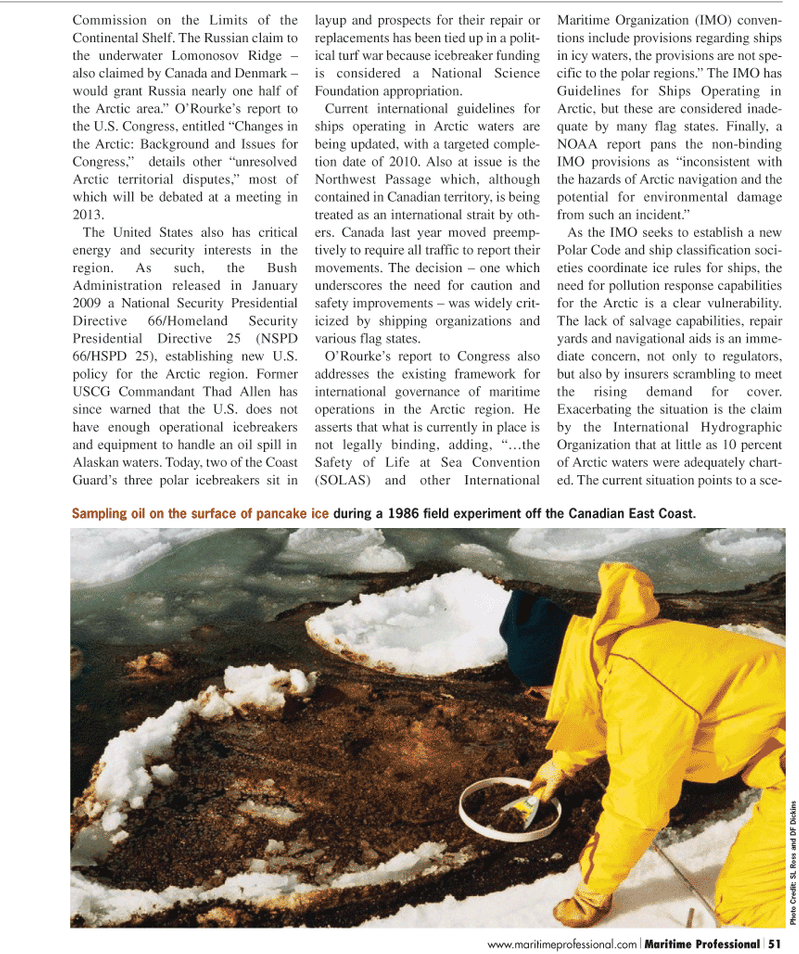
Page 51: of Maritime Logistics Professional Magazine (Q2 2011)
Energy Transportation
Read this page in Pdf, Flash or Html5 edition of Q2 2011 Maritime Logistics Professional Magazine
www.maritimeprofessional.com Maritime Professional 51
Commission on the Limits of the
Continental Shelf. The Russian claim to the underwater Lomonosov Ridge – also claimed by Canada and Denmark – would grant Russia nearly one half of the Arctic area.” O’Rourke’s report to the U.S. Congress, entitled “Changes in the Arctic: Background and Issues for
Congress,” details other “unresolved
Arctic territorial disputes,” most of which will be debated at a meeting in 2013.
The United States also has critical energy and security interests in the region. As such, the Bush
Administration released in January 2009 a National Security Presidential
Directive 66/Homeland Security
Presidential Directive 25 (NSPD 66/HSPD 25), establishing new U.S. policy for the Arctic region. Former
USCG Commandant Thad Allen has since warned that the U.S. does not have enough operational icebreakers and equipment to handle an oil spill in
Alaskan waters. Today, two of the Coast
Guard’s three polar icebreakers sit in layup and prospects for their repair or replacements has been tied up in a polit- ical turf war because icebreaker funding is considered a National Science
Foundation appropriation.
Current international guidelines for ships operating in Arctic waters are being updated, with a targeted comple- tion date of 2010. Also at issue is the
Northwest Passage which, although contained in Canadian territory, is being treated as an international strait by oth- ers. Canada last year moved preemp- tively to require all traffic to report their movements. The decision – one which underscores the need for caution and safety improvements – was widely crit- icized by shipping organizations and various flag states.
O’Rourke’s report to Congress also addresses the existing framework for international governance of maritime operations in the Arctic region. He asserts that what is currently in place is not legally binding, adding, “…the
Safety of Life at Sea Convention (SOLAS) and other International
Maritime Organization (IMO) conven- tions include provisions regarding ships in icy waters, the provisions are not spe- cific to the polar regions.” The IMO has
Guidelines for Ships Operating in
Arctic, but these are considered inade- quate by many flag states. Finally, a
NOAA report pans the non-binding
IMO provisions as “inconsistent with the hazards of Arctic navigation and the potential for environmental damage from such an incident.”
As the IMO seeks to establish a new
Polar Code and ship classification soci- eties coordinate ice rules for ships, the need for pollution response capabilities for the Arctic is a clear vulnerability.
The lack of salvage capabilities, repair yards and navigational aids is an imme- diate concern, not only to regulators, but also by insurers scrambling to meet the rising demand for cover.
Exacerbating the situation is the claim by the International Hydrographic
Organization that at little as 10 percent of Arctic waters were adequately chart- ed. The current situation points to a sce-
Sampling oil on the surface of pancake ice during a 1986 field experiment off the Canadian East Coast.
Photo Cr edit: SL Ross and DF Dickins

 50
50

 52
52
